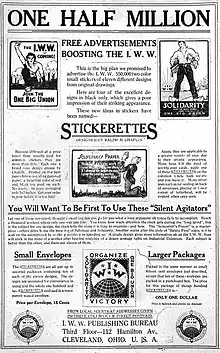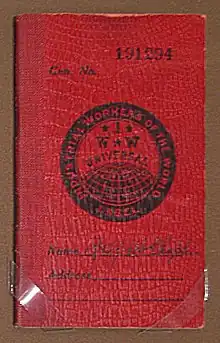Ralph Chaplin
Ralph Hosea Chaplin (1887–1961) was an American writer, artist and labor activist.
Ralph Hosea Chaplin | |
|---|---|
 | |
| Born | 1887 |
| Died | 1961 |
| Occupation(s) | Labor activist, songwriter, illustrator |
Background
Chaplin was born in 1887. At the age of seven, he saw a worker shot dead during the Pullman Strike in Chicago, Illinois. He had moved with his family from Ames, Kansas to Chicago in 1893.
Career

During a time in Mexico he was influenced by hearing of the execution squads established by Porfirio Díaz, and became a supporter of Emiliano Zapata.[1]
On his return, he began work in various union positions, most of which were poorly paid. Some of Chaplin's early artwork was done for the International Socialist Review and other Charles H. Kerr publications.
For two years Chaplin worked in the strike committee with Mother Jones for the bloody Kanawha County, West Virginia strike of coal miners in 1912–13. These influences led him to write a number of labor oriented poems, one of which became the words for the oft-sung union anthem, "Solidarity Forever".

Chaplin then became active in the Industrial Workers of the World (the IWW, or "Wobblies") and became editor of its eastern U.S. publication Solidarity. In 1917 Chaplin and some 100 other Wobblies were rounded up, convicted, and jailed under the Espionage Act of 1917 for conspiring to hinder the draft and encourage desertion. He wrote Bars And Shadows: The Prison Poems while serving four years of a 20-year sentence.
Although he continued to work for labor rights after his release from prison, Chaplin was very disillusioned by the aftermath of the Russian Revolution and the evolution of the Soviet state and international communism, particularly its involvement in American politics and unions in 1920–1948, as he details in his autobiography, Wobbly.
Chaplin maintained his involvement with the IWW, serving in Chicago as editor of its newspaper, the Industrial Worker, from 1932 to 1936. Chaplin left the IWW in 1936.[1]
Eventually Chaplin settled in Tacoma, Washington, where he edited the American Federation of Labor's local labor publication. He converted to Roman Catholicism and published his autobiography Wobbly.[1] From 1949 until his death, he was curator of manuscripts for the Washington State Historical Society.
Death
Chaplin died in 1961.[1]
Legacy

According to the IWW, Chaplin likely designed the now widely used anarcho-syndicalist image, the black cat.[2] As its stance indicates, the cat is meant to suggest wildcat strikes and radical unionism.
In 2022, law professor Ahmed White included Chaplin in his book on the IWW called Under the Iron Heel.[3]
Works

There are ten entries for Chaplin's works in the Library of Congress online catalog.
- Illustrations
- Out of the Dump (1909)[4]
- Poetry
- When the Leaves Come Out and Other Rebel Verses (1917)[5]
- Bars and Shadows: The Prison Poems (1922)[6]
- Bars and Shadows: The Prison Poems (1923)[7]
- Nonfiction
- The Centralia Conspiracy (1920)[8]
- American Labor's Case Against Communism: How the Operations of Stalin's Red Quislings Look from Inside the Labor Movement (1947)[11]
- Wobbly: The Rough-and-Tumble Story of an American Radical (1948)[12]
- Wobbly: The Rough-and-Tumble Story of an American Radical (1972)[13]
- Articles
- "Confessions of a Radical," two-part article in Empire Magazine of the Denver Post (February 17, 1957, pp. 12–13, and February 24, 1957, pp. 10–11)
- "Why I Wrote Solidarity Forever," American West, vol. 5, no. 1 (January 1968), 18–27, 73
See also
References
- "Ralph Chaplin". Spartacus Educational. Retrieved 2023-09-14.
- "The Black Cat (Sabo-Tabby) | Industrial Workers of the World".
- Ahmed White (2022). Under the Iron Heel: The Wobblies and the Capitalist War on Radical Workers. University of California Press. pp. 19, 20, 22, 24, 28, 42, 48, 56, 59–60, 84, 85–87, 104, 118, 122, 133, 190–191, 204, 223, 233. ISBN 9780520382411. LCCN 2021062860. Retrieved 25 February 2023.
- Mary March (1909). "illustrations by R. H. Chaplin". Out of the Dump. Charles H. Kerr. LCCN 08037707. Retrieved 25 February 2023.
- Ralph Chaplin (1917). When the Leaves Come Out and Other Rebel Verses. Charles H. Kerr. LCCN 17005831. Retrieved 25 February 2023.
- Ralph Chaplin (1922). "introduction by Scott Nearing". Bars and Shadows: The Prison Poems. Leonard Press. LCCN 17005831. Retrieved 25 February 2023.
- Ralph Chaplin (1923). "introduction by Scott Nearing". Bars and Shadows: The Prison Poems. Nellie Seeds Nearing. LCCN 82464851. Retrieved 25 February 2023.
- Ralph Chaplin (1920). The Centralia Conspiracy. Geo. Williams. LCCN 23007468. Retrieved 25 February 2023.
- Ralph Chaplin (1924). The Centralia Conspiracy: The Truth About the Armistice Tragedy. General Defense Committee. LCCN 24012135. Retrieved 25 February 2023.
- Ralph Chaplin; Ben Hur Lampman (1971). Centralia Case: Three Views of the Armistice Day Tragedy at Centralia, Washington, November 11, 1919. Da Capo Press. LCCN 77160845. Retrieved 25 February 2023.
- Ralph Chaplin (1947). American Labor's Case Against Communism: How the Operations of Stalin's Red Quislings Look from Inside the Labor Movement. Educator Publishing Co. LCCN 47025519. Retrieved 25 February 2023.
- Ralph Chaplin (1948). Wobbly: The Rough-and-Tumble Story of an American Radical. University of Chicago Press. LCCN 48008467. Retrieved 25 February 2023.
- Ralph Chaplin (1972). Wobbly: The Rough-and-Tumble Story of an American Radical. Civil liberties in American history. Da Capo Press. ISBN 9780306702129. LCCN 70166089. Retrieved 25 February 2023.
External links
 Media related to Ralph Chaplin at Wikimedia Commons
Media related to Ralph Chaplin at Wikimedia Commons Quotations related to Ralph Chaplin at Wikiquote
Quotations related to Ralph Chaplin at Wikiquote Works by or about Ralph Chaplin at Wikisource
Works by or about Ralph Chaplin at Wikisource- Works by Ralph Chaplin at Project Gutenberg
- Works by or about Ralph Chaplin at Internet Archive
- Works by Ralph Chaplin at LibriVox (public domain audiobooks)

- CHAPLIN, Ralph Hosea (1887-1961), papers, Special Collections, Washington State Historical Society
- Grave of Ralph Chaplin Calvary Cemetery, Tacoma, Washington